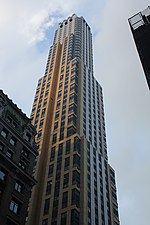Lord & Taylor Building

The Lord & Taylor Building is an 11-story commercial building in Midtown Manhattan, New York City, that formerly served as Lord & Taylor's flagship department store in the city. Designed by Starrett & van Vleck in the Italian Renaissance Revival style, it is at 424–434 Fifth Avenue between 38th and 39th Streets. Since 2023, it has been an office building for Amazon. The building's facade is made of limestone on the lower stories and gray brick on the upper stories, capped by a copper cornice. The structure contains a chamfered corner at the intersection of Fifth Avenue and 38th Street, and it wraps around another building at Fifth Avenue and 39th Street. The store had multiple entrances, including a barrel-vaulted arch on Fifth Avenue The building was designed with several features that enabled the store to function efficiently, such as delivery ramps and movable window displays on elevators. The above-ground floors were connected via various elevators and stairs; there were no retail areas on the tenth floor. The building was constructed from 1913 to 1914 and served as Lord & Taylor's flagship store for over a hundred years. It was described as the first "frankly commercial" structure on Fifth Avenue north of 34th Street, and it replaced several of the company's previous headquarters. During the building's operation as Lord & Taylor's flagship store, it was renovated several times, and by the late 20th century, the store had expanded into an adjacent building. The Lord & Taylor Building was designated a city landmark by the New York City Landmarks Preservation Commission on October 30, 2007. The building was mostly sold in a joint venture to workspace company WeWork in 2019. Amazon acquired the building in 2020, and opened an office there in mid-2023.
Excerpt from the Wikipedia article Lord & Taylor Building (License: CC BY-SA 3.0, Authors, Images).Lord & Taylor Building
5th Avenue, New York Manhattan
Geographical coordinates (GPS) Address Nearby Places Show on map
Geographical coordinates (GPS)
| Latitude | Longitude |
|---|---|
| N 40.751388888889 ° | E -73.983055555556 ° |
Address
5th Avenue 424
10018 New York, Manhattan
New York, United States
Open on Google Maps









